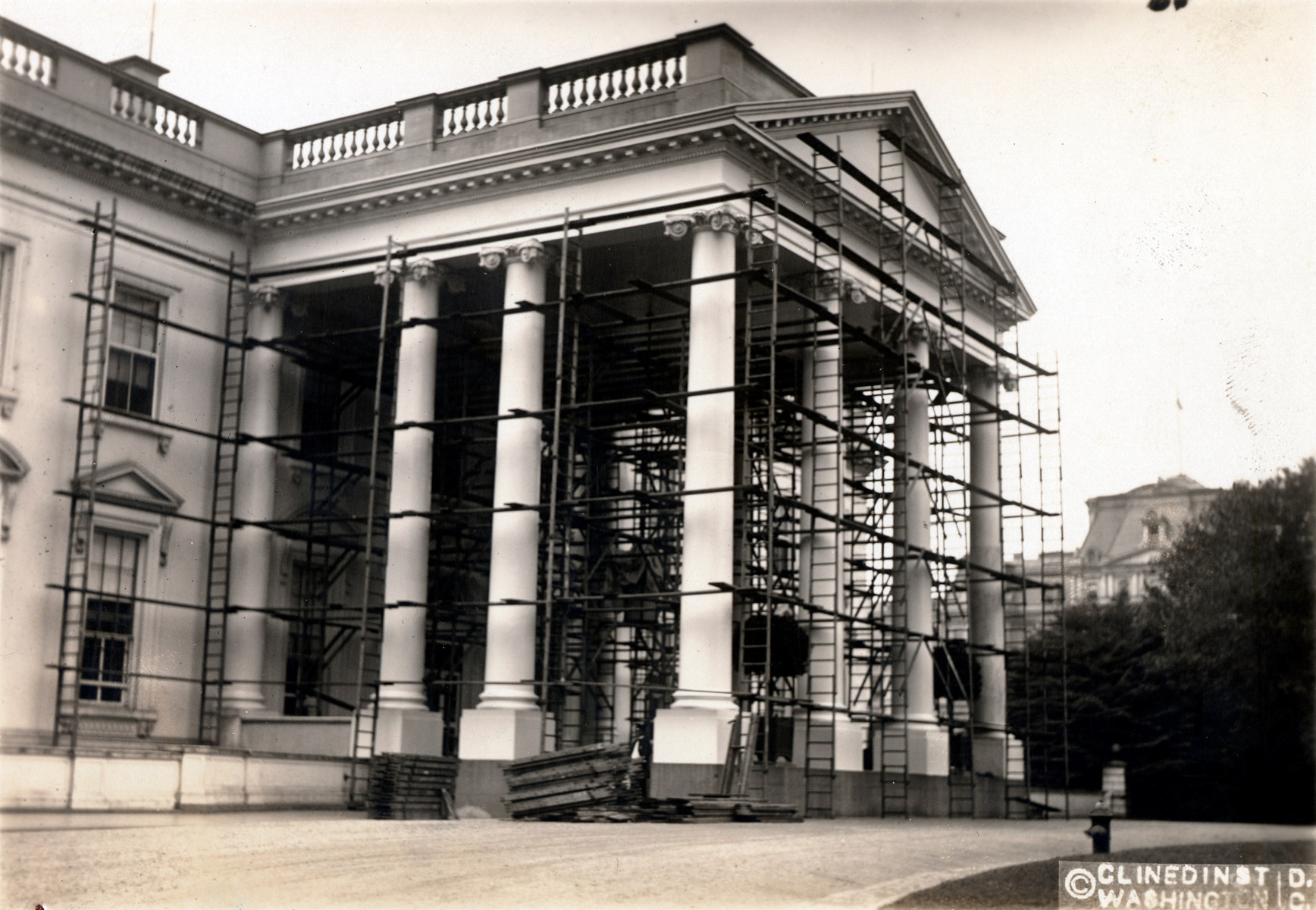Event White House History Live: Coming to Terms with John F. Kennedy
Join us in learning more about White House History right from your own home. Our Facebook Live series, White House...
Main Content
Have you ever wondered...
Yes, many, many times! Today there is a marker embedded in the floor of the White House Entrance Hall which includes the dates of the four major instances of White House construction and renovation: 1792, 1817, 1902, 1952. 1792 represents the year that the cornerstone was laid, and construction began on the White House. 1817 marks the rebuild of the White House after the British burned it on August 24, 1814. 1902 commemorates the Theodore Roosevelt renovation which modernized the White House for the twentieth century and established the West Wing as the new executive office space for the president and their staff. 1952 marks the completion of the Harry S. Truman Renovation (1948-1952), which completely gutted and rebuilt the White House from the inside. While not included on this marker, there was also another significant renovation that took place in 1927 during the Calvin Coolidge administration.
In addition to these major renovations, there have been numerous other changes to the White House over the years. As technology advanced, new means of heating, plumbing, lighting, and cooling were installed at the White House. Since the last major renovation by Harry S. Truman, every president and first lady has made changes inside the White House but in very different ways. Some have renovated or refurbished rooms—for example, the Blue Room underwent renovations by Jacqueline Kennedy, Thelma “Pat” Nixon, and Hillary Clinton. Some have added artwork, portraiture, and furniture to the White House Collection—for example, Mamie Eisenhower accepted a gift of 1,575 pieces of vermeil; Michelle Obama secured Alma Thomas’ painting Resurrection, the first work of an African-American woman in the collection; and Melania Trump acquired Isamu Noguchi’s sculpture Floor Frame for the White House Rose Garden. Others have supported exterior projects on the White House Grounds—for example, Claudia “Lady Bird” Johnson oversaw the redesign of the East Garden and the creation of the Children’s Garden; Gerald R. Ford ordered an outdoor swimming pool to be built; and Michelle Obama created the White House Kitchen Garden on the South Lawn. Every first family leaves its mark on the home, and while some of these changes can be temporary, others continue into the next administration and beyond.

This photographs of the construction of the East Terrace was taken in 1902, during Theodore Roosevelt's administration. Soon after he assumed office, Roosevelt ordered a major White House renovation, establishing a design that has remained largely in place ever since. His plan included the reconstruction of the East Terrace, part of an earlier White House design that had been demolished. The terrace became part of the East Wing, which originally served as a visitor's entrance. This photograph appeared in a report to the Senate which provided an overview of the project. This is a black and white photograph developed into silver gelatin and platinotypes.
White House Historical Association
This black and white photograph by prominent Washington, D.C. photographer Barnett McFee Clinedinst shows scaffolding on the North Portico of the White House during a renovation. Clinedinst opened a photography studio in the capital with his father, and went on to become the official White House photographer for Presidents Theodore Roosevelt, William H. Taft, and Woodrow Wilson.
White House Collection
This photograph by Abbie Rowe of the National Park Service shows steel frame towers built to support the third floor and the roof while the rest of the house was demolished. This work was part of President Harry S. Truman's large-scale 1948-1952 renovation of the White House.
White House Collection
This is a photograph of President Gerald R. Ford and his daughter Susan Ford surveying the progress of construction on the new outdoor swimming pool on the South Grounds.
Gerald R. Ford Presidential Library and Museum/NARAWe've Also Been Asked...
Join us in learning more about White House History right from your own home. Our Facebook Live series, White House...
The White House Historical Association is seeking a Store Manager to work on location in our Washington D.C. Gift...
Paul Jennings, an enslaved man in the James Madison White House, was an eyewitness to history as British troops approached...
Join us in learning more about White House History right from your own home. Our Facebook Live series, White House...
The White House Historical Association released a new episode of “The White House 1600 Sessions” podcast today featuring a conversation with Dame...
The White House Historical Association, in partnership with the John W. Kluge Center at the Library of Congress, hosted its...
Britain and the U.S. have long had what Prime Minister Winston Churchill called a “special relationship.” From adversaries to alli...
Join us for our virtual History Happy Hour program on Thursday, April 27th at 6:00 pm to hear Dr. Donald Fixico...
Lady Bird Johnson was a groundbreaker, a savvy business woman, an indispensable right-hand to her political husband, a mother, an...
The White House Historical Association debuted a new virtual exhibit today, Slavery and Freedom in the White House Collection, that...
The White House Historical Association released a new episode of “The White House 1600 Sessions” podcast today featuring a conversation with Iain...
The fight for emancipation throughout the antebellum era is also represented in the White House Collection.